When I think of Spain, the image of a Sevillian woman always comes to me. With her dresses, her big earrings, the color of her hair, her manner of speaking. I also see beautiful horses, castanets, big earrings.
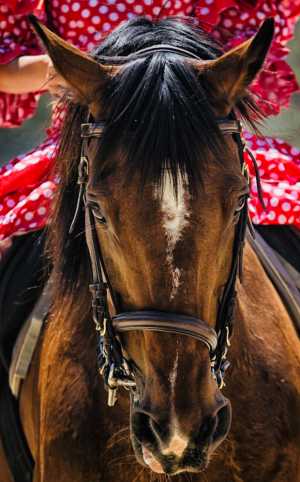
Those are the first images I have. I hear Sevillanas in the background, like a soundtrack. And, I love having those images, they are so faithful, so beautiful, so full of life.
Seville is the perfect weekend getaway. We went for a long weekend and I consider it the ideal time to explore this beautiful city and learn more about its history.
They say, out there, that Seville has a special color. Seville is guarded by streets of smell of incense. In Seville the sun shines and art is on the street.
It is one of the most perfect places to lose yourself and find yourself. The city is located south of the Iberian Peninsula, it is the capital of Andalusia.
Location and weather
Seville is the capital of Andalusia. It is the fourth most populous city in Spain, being one of the cultural, industrial and financial centers of the south of the country.
The city is located in the western half of Andalusia, on the banks of the Guadalquivir River, which divides the city into two halves. One of them is La Isla de la Cartuja, and the neighborhoods of Triana and the Remedies to the west, and the center and restaurant of the neighborhoods to the east. The Guadalquivir flows into Sanlúcar de Barrameda (in the province of Cádiz) after crossing the Doñana Park.
It is a real pleasure to get lost in a city with the charm of Seville. Seville’s climate is characterized by its high temperatures in summer (> 40ºC) and its mild winters (> 4ºC), with sporadic but intense rains. It is preferable to go in spring, when temperatures are around 25 ° C.
Everything to discover
It stands out for its great artistic, architectural importance and for its throbbing history that is still felt in the old town.
In a city as charming and lively as Seville, one has to work hard not to have a wonderful weekend. Its colorful and romantic streets and squares, an endless supply of modern and traditional bars and restaurants and its historical attractions mean that the Andalusian capital will not disappoint.

As always there are a thousand things to do. The Andalusian capital has monuments such as the Cathedral, the Plaza de España, the Torre de Oro or the Giralda. However, just walking through its streets allows one to become infected with its magic.
As if this were not enough, I love knowing that Seville has been the inspiration and muse of many artists. By this I mean that there are many songs that have been written thinking of Seville. Some of them are: Sevilla by Miguel Bosé, Back to Sevilla by Alejandro Sanz, Dos Cruces by Antonio Molina, Sevilla by Rocío Jurado, Sevilla by Medina Azahara or Sevilla has a special color by Los del Río.
To my liking, this is the most representative song of Seville, everyone knows it. His words are one hundred percent true. You don’t need anything more than this: Seville falls in love with the sky to dress it in blue … Seville, so affectionate, so gypsy brunette.
If there is something that I adore, it is the way of being that Sevillians have. Its people have closeness, sympathy and joy that spread to everyone who visits the city and walks through its streets.
A rich and exciting story
I learned that there are many legends surrounding its origin. Some people associate it with the one founded by Hercules himself, who would give it to his Hispanic son. From this fact would come the term “hispalis”. Others say that the city was founded by the Iberian tribe of the Turdetans who inhabited the Guadalquivir valley, territory that corresponded with the ancient Tartessos.
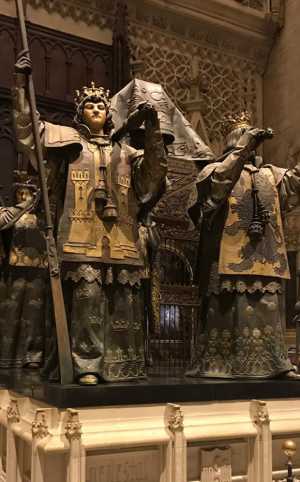
In 205 B.C. Seville was usurped from the Carthaginians by the Romans in the course of the Second Punic War. For two centuries he participated in the convulsive history that the Roman metropolis lived. The city was taken by Julius Caesar in 43 BC and made it the most important city in the Roman province of Betica.
After the fall of Rome the Siling Vandals occupied it until they were expelled by the Visigoths, who made it one of the capitals of their reign.
As is evident Seville has always been a land desired by different civilizations. Lands loved by Phoenicians, Tartessians, Romans, Visigoths, Arabs, Christians . Various stories have located Atlantis a few kilometers from Seville.
Other curious facts are that Numerous churches in the city were mosques in the Arab era preserving wonderful elements of that style, without going further the cathedral: visit the Patio de los Naranjos, the authentic sahn of the main mosque. 5 minutes from Seville is Italica, the first Roman city that was founded outside the cradle of the Empire.
La Giralda, the Cathedral and the Real Alcazar.
In every corner of the center of Seville you will breathe history. There are many places that give you that feeling, since the old town of Seville is one of the largest in the world and the largest in Spain.
And this is how you get to the spectacular Giralda. This tower has dominated the heights for almost a millennium. It has a mixture of styles, cultures and civilizations that enrich us.
The bell body of the Giralda consists of 24 bells plus 1 upper.
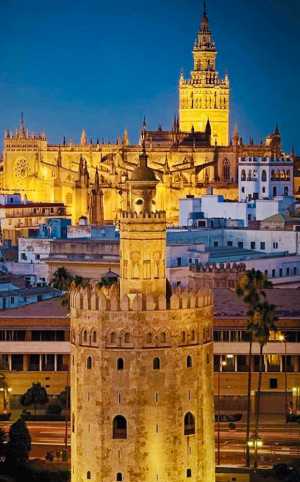
La Giralda is the bell tower of the Cathedral. In its day it was the tallest tower in the world with its 97.5 m height. Needles to say, it is one of the most famous images of the city and all of Andalusia. The tower is constituted by two different bodies although perfectly united, showing a perfect example of the melting pot of cultures existing in the city.
The Muslim part is the oldest, it was started in 1184 by order of Abu Yaqub Yusuf to be the minaret of the Almohad mosque of Seville. Although there are no stairs, there are 35 wide ramps that allowed the Sultan to ride on horseback.
In the 16th century, the Christian part was added. The bell tower was in charge of the architect Hernán Ruiz. The part of the lilies, which has four jugs of bronze lilies, one in each corner. And on top of this there is another body of Renaissance style.
As a curious fact, on December 29, 1928, it was declared a National Heritage and in 1987, it integrated the list of World Heritage.
The Real Alcazar of Seville is a walled palace complex built in different historical stages. Although the original palace was built in the High Middle Ages, islamic and gothic art still remains in the building.
Since the High Middle Ages this walled enclosure has served as a residence for kings from different eras. It is currently the official residence in Seville of the Kings of Spain. This means that it is the largest fortified space in Europe.
The flamenco
Flamenco is music, singing, dancing, poetry, feeling … and a whole philosophy. Flamenco is also called “cante jondo”.

Flamenco is surely the purest expression of Andalusian folklore. They say that their origins are related to the arrival of the Roma in the fifteenth century to the Cadiz countryside of Jerez and Seville. In the mid-nineteenth century it became popular through the singing cafes.
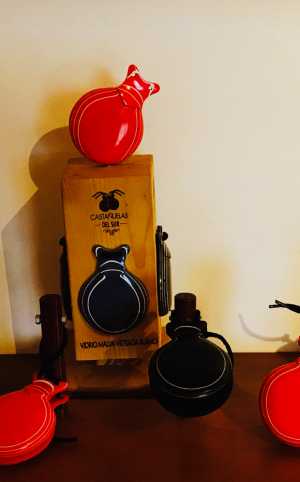
The first of these singing cafes opened its doors around 1885. Until then flamenco had not left family gatherings or private parties.
Flamenco has its origins in Andalusia.
Long ago people lived in multi-family homes, it had rooms that surrounded an inner courtyard. It was exactly there where the first dances and songs arose. Then they came to the canteen singers of the nineteenth century.
It is possible to see flamenco art every day, this is amazing for me. This is possible in the well-known flamenco tablaos, in the neighborhood clubs, in thematic spaces, in certain bars and in festivals such as the Flamenco Biennial.
It was very interesting for me to discover the Flamenco Dance Museum. It is the first and only museum of this kind in the world. A modern museum that preserves the root of the old.
I believe that the Flamenco Dance Museum is an excellent gateway to the magical world of flamenco. A unique experience where the various facets of this art come together: dance, song and guitar.
Triana neighborhood
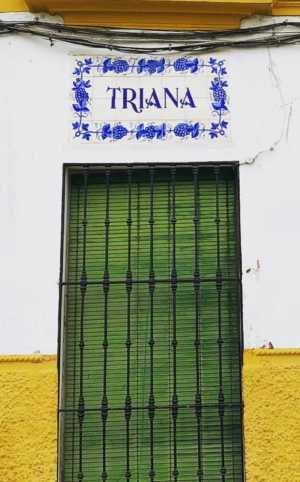
The history of flamenco is closely linked to Andalusia, more punctually to Seville and with much greater precision, to the Triana neighborhood.
The Triana neighborhood is located on the east bank of the Guadalquivir River and, separated from the rest of Seville by the river basin, is linked to the city by the Triana bridge.
The Triana neighborhood is a key point for Sevillian and Spanish culture: it retains a long tradition of potters, plastic artists, singers and flamenco dancers. The potters’ workshops are located in the vicinity of the Plaza del Altozano, mainly on Calle Alfarería.
In the Paso de la O, which is located in the old jetty area and extends along the riverbank, the artists exhibit their works during the weekends. Finally, the neighborhood bars serve as tablao for the many flamenco artists in the area.
The Triana bridge leads directly to the Plaza de Altozano, a historic meeting place for travelers coming from different points to Seville and had to cross the old boat bridge to reach it. The square houses the famous market of Triana, the place where locals shop daily. There it is possible to find fresh fruits and vegetables, fish, meat and cheeses, but also flowers, craft beer, pottery and other merchandise.
Leaving the market of Triana is the Castle of San Jorge, a fundamental historical site of the neighborhood, built on an ancient Visigoth fortification. It was very important during the inquisition. Currently, the castle is an information center about this dark Catholic moment.
The gastronomy
Seville is one of the most important cities in Spain. And, although it is necessary to immerse yourself in the past of a city, I believe that there is no better way to know its history, its past than that of its flavors, colors and smells. In other words: gastronomy. Typical Sevillian cuisine has olive oil as an excellent base for most of its dishes.
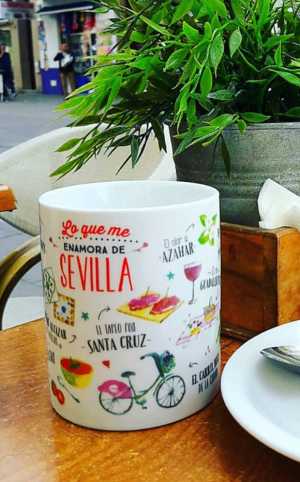
n the city it is common to eat tapas. For those who do not know, tapas are small portions that are usually taken accompanied by a drink (sweet wines are common) that offer the possibility to try different dishes without filling up too much.
Some of the typical dishes are:
Pringá: it is one of the typical tapas dishes of the city. Emerged from the idea of taking advantage of the remains of the stew, it is as simple to prepare as to shred the remains of meat to spread them on a small spongy bread.
Gazpacho: Gazpacho is one of the most typical dishes of Andalusia, especially during the hot summer months. It is a cold soup prepared with tomatoes, peppers and cucumber.
Fried fish: Simple to prepare and very grateful, small fish that are battered in flour and fried in olive oil are often used in this dish. It is common to be served in paper cones.
Aliñás potatoes: One of the most typical tapas in Seville is aliñás potatoes, cooked potatoes that are served cold and seasoned with olive oil, vinegar, scallions and parsley.
Flamenco eggs: As it sounds, this typical dish consists of a fried egg that is served with vegetables and sauce.
I want to make it very clear that you can eat very well in almost any place.
Having said that, one of the most recommended areas is the Santa Cruz neighborhood. Another option may be the Triana neighborhood.
Summing up about charming corners
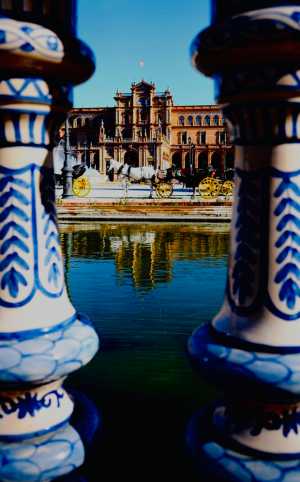
Summarizing all those charming corners that a city like Seville hides is a complicated task. It is a charming city that moves to the rhythm of flamenco.
They have an intense and positive way of life. Hospitality is a natural thing for them.
In Seville the streets and squares are places that breathe a kind of outdoor comfort.
I fell in love with this city since before I met her. And, on the first visit I made, I reiterated the reason.
With subsequent trips I have realized the beauty and what this city really means to me. A city where I feel, where I feel free and where I would love to spend a large part of my life.


